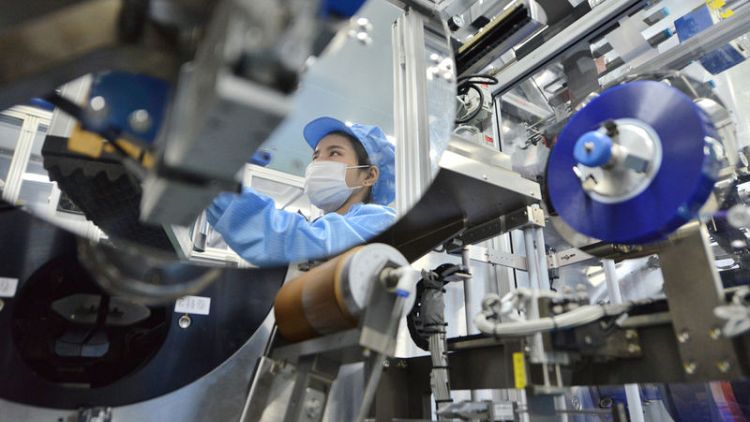BEIJING (Reuters) - Growth in China's manufacturing sector unexpectedly picked up in August after a two-month slide, offering some cushion for the slowing economy as the United States rapidly ratchets up tariffs on Chinese goods.
The respite may prove brief, however. Export orders shrank for a third straight month, suggesting a flurry of punitive U.S. trade measures are starting to bite.
The official Purchasing Managers' Index (PMI) released on Friday rose to 51.3 in August, from 51.2 in July, remaining above the 50-point mark that separates growth from contraction for a 25th straight month.
Analysts surveyed by Reuters had forecast the reading would dip slightly for a third straight month to 51.0.
The PMI reading shows China's manufacturing sector is continuing to expand at a steady pace, statistics bureau official Zhao Qinghe said in a statement with the data.
But he acknowledged international trade frictions and other external uncertainties are hurting exports and imports.
The PMI sub-index on new export orders indicated contraction for a third straight month and was at the lowest level since February at 49.4, compared to 49.8 in July.
The import sub-index, considered a gauge of domestic demand, was at the lowest level in at least a year at 49.1, down from 49.6 in July.
Weighed down by rising financing costs, China's economy was already starting to cool even before the trade dispute with Washington escalated, with investment growth at a record low and consumers turning more cautious about spending.
That has prompted Beijing to speed up infrastructure spending and offer help to smaller companies to prevent a sharper slowdown, though policymakers are wary of adding to a mountain of debt that was fuelled by past stimulus binges.
U.S. and Chinese officials ended two days of talks last Thursday with no major breakthrough as their trade war escalated with activation of another round of duelling tariffs on $16 billion worth of each country's goods.
U.S. tariffs on another $200 billion of Chinese goods ranging from furniture to bicycles are expected to take effect next month.
While China's official export data has been largely resilient so far, analysts suspect that may be due to companies rushing out shipments before further tariffs kick in, raising the risk of a sharp dropoff in coming months.
Chinese exports may only grow 2 percent in yuan terms in the second half of this year, the State Information Center under the National Development and Reform Commission predicted. That compared with a 4.9 percent rise in first half.
A production sub-index rose to 53.3 in August from 53.0 in July, while a new orders sub-index declined to 52.2 from 52.3.
A sister survey released by the NBS showed growth in China's services sector also picked up in August, with the official non-manufacturing Purchasing Managers' Index (PMI) rising to 54.2 from 54.0 the previous month.
Chinese policymakers are counting on growth in services and consumption to rebalance their economic growth model from its heavy reliance on investment and exports. The services sector now accounts for more than half of the economy, with rising wages giving Chinese consumers more spending clout.
But retail sales unexpectedly moderated in July despite a broad import tax cut last month, indicating consumers are turning more cautious, while disposable income is rising at a slower pace.
(Reporting by Lusha Zhang and Elias Glenn; Editing by Kim Coghill)



